Enhancing Customer Relationships: Mastering the Art of Follow-up Letters With 25-Templates
Welcome to our “Customer Service Follow-up Letters” page. We understand the importance of maintaining strong customer relationships and providing exceptional service beyond the initial interaction. Our follow-up letters are designed to express gratitude, address concerns, and nurture long-lasting connections with our valued customers. Whether you’re seeking guidance on writing effective follow-up letters, exploring customization options, or learning about the significance of timely communication, we have you covered. Join us as we delve into the art of crafting personalized, impactful, and timely follow-up letters to leave a lasting impression on your customers.
Tips for Writing Effective Follow-up Letters
- Personalize the Letter: Address the recipient by name and reference specific details from previous interactions to create a personalized touch. This demonstrates that you value the individual and their unique experience.
- Address Customer Concerns: If the customer had any concerns or issues, address them directly in the follow-up letter. Acknowledge their feedback, apologize if necessary, and provide reassurance that their concerns are being addressed.
- Express Appreciation: Show genuine gratitude for the customer’s business, feedback, or participation. Let them know that their support and engagement are valued and appreciated.
- Provide Relevant Information: Include any relevant information or updates that the customer may find useful. This could be additional resources, recommendations, or upcoming events that align with their interests.
- Keep the Letter Concise and Clear: Make sure your follow-up letter is concise and easy to understand. Use clear and simple language, and avoid unnecessary jargon or complex terminology. Keep the focus on the customer and their needs.
- Use a Friendly and Professional Tone: Strike the right balance between a friendly and professional tone. Be warm, approachable, and empathetic while maintaining a level of professionalism that reflects your brand.
- Offer Assistance: Let the customer know that you are available to assist them further if needed. Provide contact information or instructions on how they can reach out to you for any additional questions or support.
- Proofread and Edit: Before sending the follow-up letter, proofread it carefully to ensure there are no spelling or grammatical errors. Editing helps to refine the message and improve clarity.
- Follow-Up Timing: Send the follow-up letter promptly to maintain the relevance and freshness of the interaction. Aim to send it within a reasonable timeframe after the initial interaction or event.
- End on a Positive Note: Conclude the follow-up letter with a positive and encouraging statement. Reinforce your commitment to customer satisfaction and express your desire to continue serving them in the future.
#1: Thank you for your recent purchase:
Expressing gratitude to the customer for their recent purchase and reinforcing their decision to choose your product or service. We want to express our sincere gratitude for your recent purchase with [Your Company]. Your decision to choose our product/service is greatly appreciated. We are delighted that you have put your trust in us and are confident that our offering will meet and exceed your expectations. We are committed to providing you with exceptional quality, functionality, and service, and we look forward to supporting you in achieving your goals. Thank you once again for your valued business.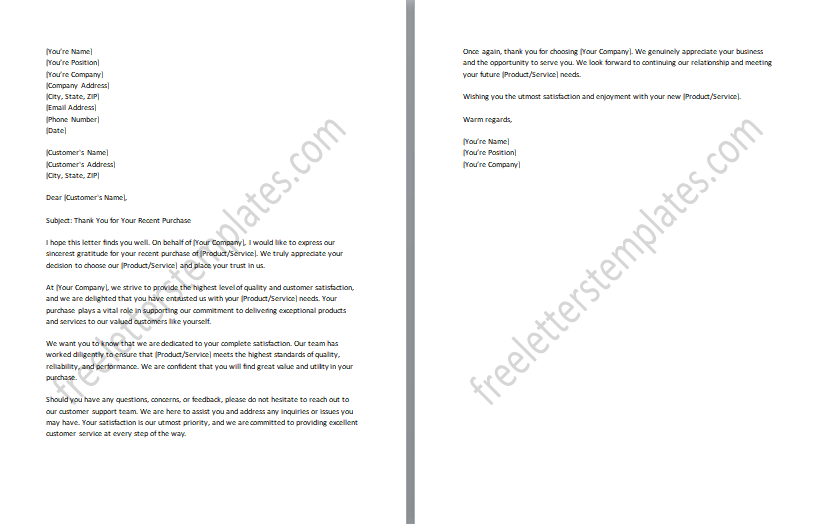
#2: Apology for the shipping delay:
Acknowledging a delay in shipping and apologizing for any inconvenience caused to the customer, while assuring them that their order will be delivered promptly. The purpose of this letter is to apologize to the customer for the delay in shipping their order and express our sincere regret for any inconvenience caused. We understand the importance of timely delivery and want to assure the customer that their order will be delivered promptly. We aim to maintain open communication, address their concerns, and reinforce our commitment to providing exceptional service.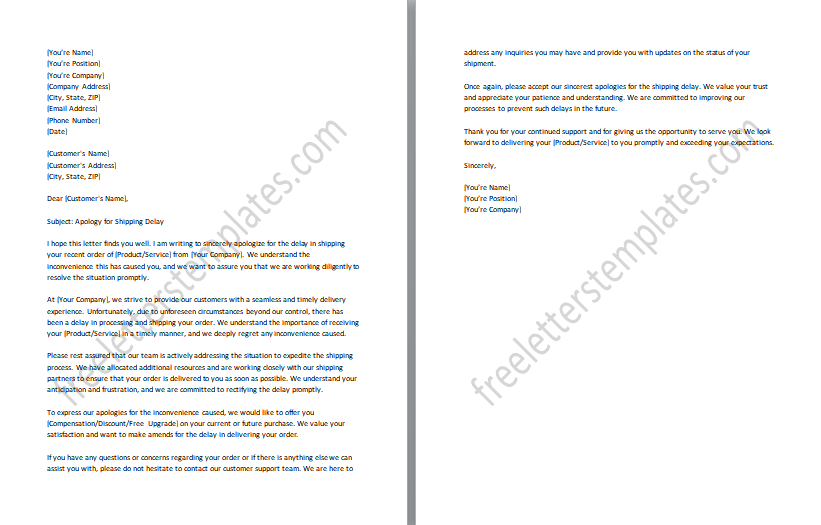
#3: Follow-up after a product return:
Checking in with the customer after they have returned a product, ensuring their satisfaction with the return process, and addressing any concerns or issues they may have. The purpose of this letter is to follow up with the customer after they have returned a product. We aim to ensure their satisfaction with the return process and address any concerns or issues they may have encountered. We genuinely care about their experience and want to make sure everything went smoothly. By checking in with them, we aim to provide any necessary assistance and ensure their complete satisfaction.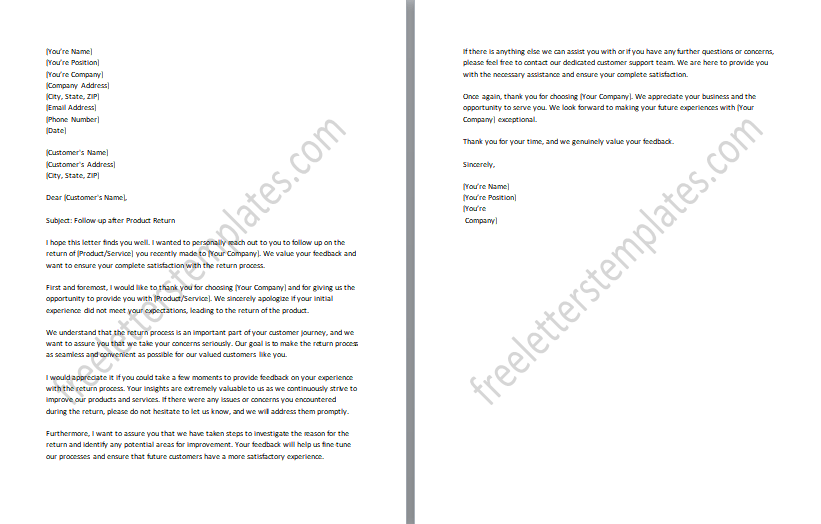
#4: Resolution of a customer complaint:
Informing the customer about the successful resolution of their complaint, outlining the steps taken to address their concerns, and expressing appreciation for their feedback. The purpose of this letter is to inform the customer about the successful resolution of their complaint. The tone of the letter should be highly human-like, expressing understanding, empathy, and appreciation for their feedback. The letter should outline the steps taken to address their concerns and assure the customer that their concerns were taken seriously and addressed promptly.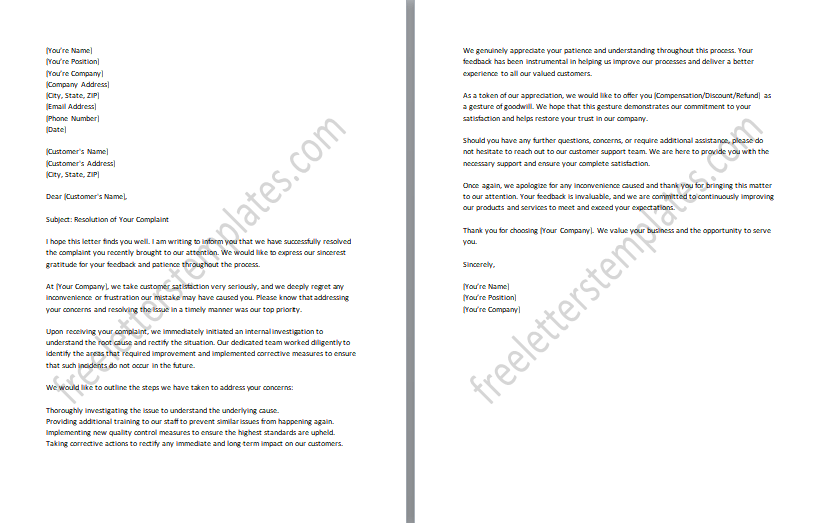
#5: Confirmation of an appointment or reservation:
Confirm the details of a scheduled appointment or reservation, including date, time, and any additional instructions, to ensure a smooth customer experience. The purpose of this letter is to confirm the details of a scheduled appointment or reservation, aiming to provide the customer with a smooth and organized experience. The main objective is to ensure that the customer has accurate information about the date, time, and any additional instructions related to their appointment or reservation. By confirming these details, we seek to instill confidence in the customer and demonstrate our commitment to delivering a seamless and satisfactory service.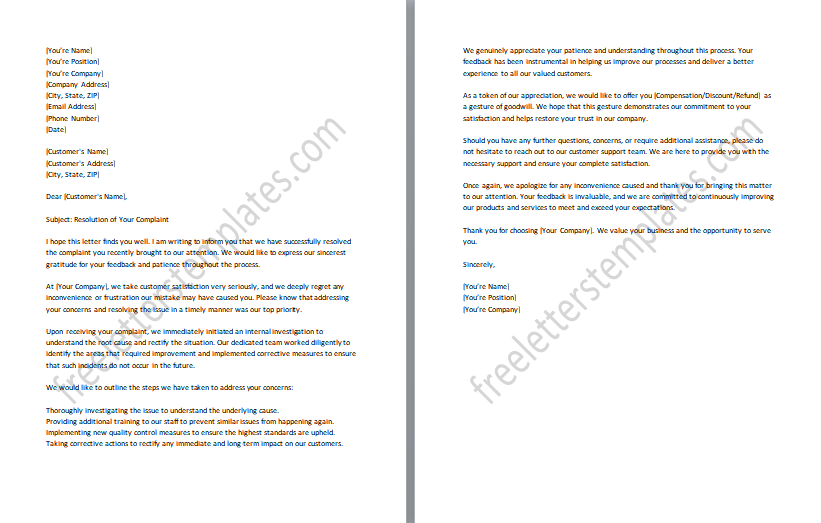
#6: Follow-up after a service call or repair:
Checking in with the customer to ensure their satisfaction with the service or repair performed, addressing any additional needs or concerns they may have, and providing any necessary post-service instructions. The purpose of this letter is to follow up with the customer after a service call or repair to ensure their satisfaction. The main objective is to check in with the customer, address any additional needs or concerns they may have, and provide any necessary post-service instructions. By reaching out, we aim to demonstrate our commitment to their satisfaction and provide ongoing support to ensure their experience with our service remains exceptional.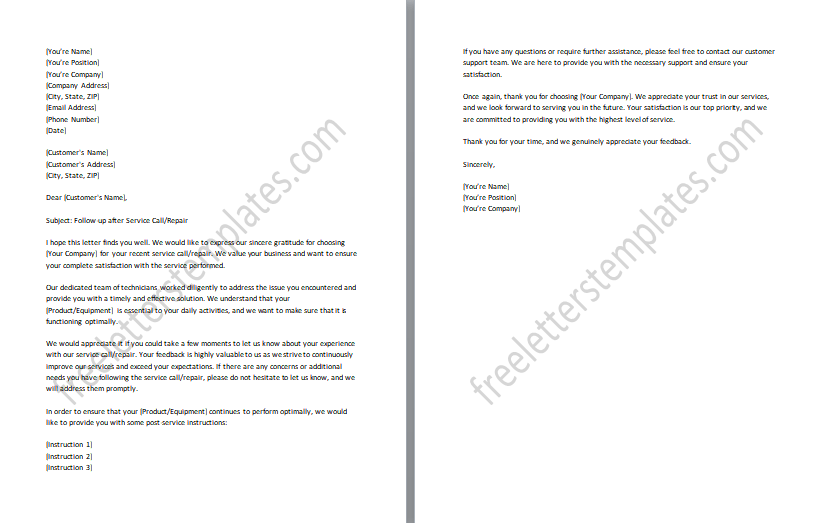
#7: Request for feedback on a recent interaction:
Seeking feedback from the customer regarding their recent interaction with your customer service team, encouraging them to share their thoughts and suggestions to help improve future experiences. The purpose of this letter is to request feedback from the customer regarding their recent interaction with our customer service team. The letter aims to encourage the customer to share their thoughts and suggestions to help us improve future experiences. By seeking their feedback, we demonstrate our commitment to providing exceptional service and value their input in shaping our customer service practices.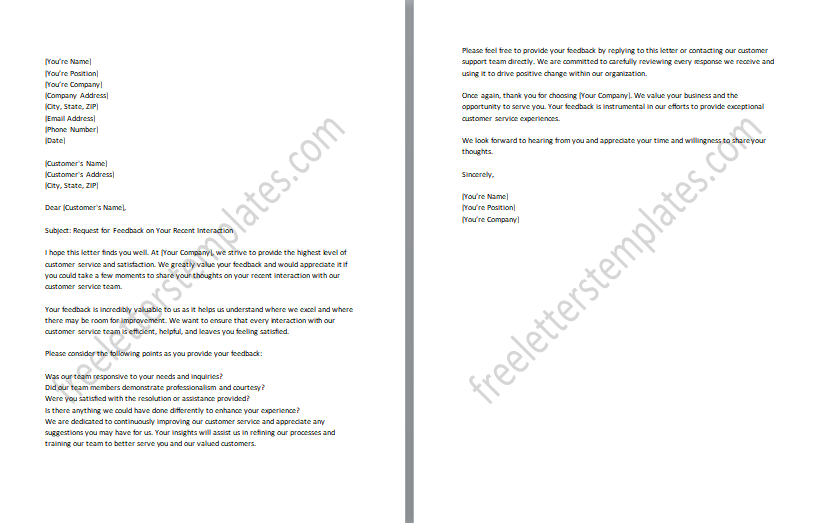
#8: Acknowledgment of a customer suggestion or idea:
Thanking the customer for their valuable suggestion or idea, acknowledging its potential benefits, and informing them of any actions taken or implementation plans. The purpose of this letter is to acknowledge and thank the customer for their valuable suggestion or idea. The letter aims to express gratitude for their contribution, acknowledge the potential benefits of their suggestion, and inform them of any actions taken or implementation plans. By reaching out, we demonstrate our commitment to listening to our customers and continuously improving our offerings based on their valuable input.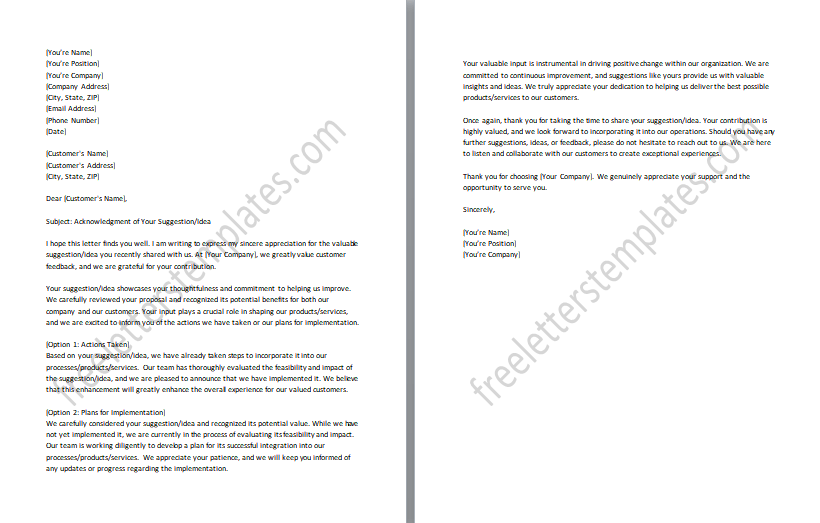
#9: Follow-up after a product inquiry or demo:
Following up with the customer after they have shown interest in a product or requested a demo, providing additional information, addressing any questions, and offering assistance in making a purchase decision. The purpose of this letter is to follow up with the customer after their product inquiry or demo request. The letter aims to provide additional information, address any questions or concerns they may have, and offer assistance in making a purchase decision. By reaching out, we aim to provide a personalized and helpful experience for the customer, ensuring they have the necessary information and support to make an informed decision about our product.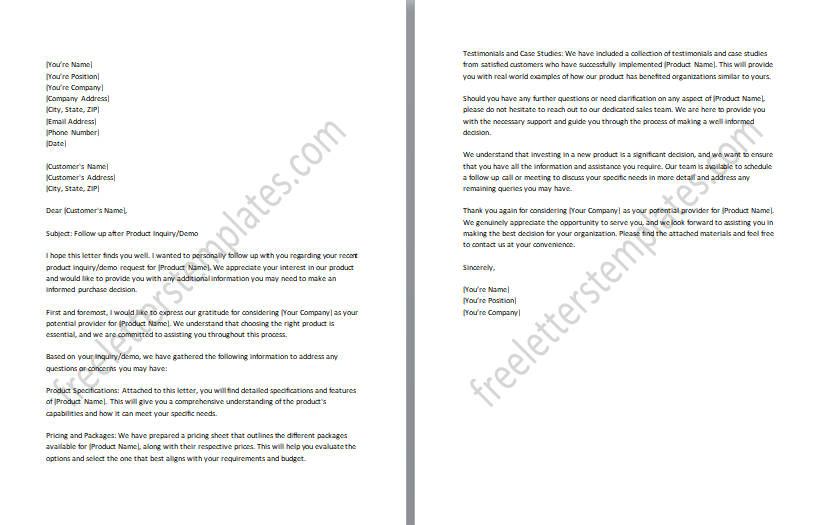
#10: Update on a product recall or safety concern:
Informing customers about a product recall or safety concern, providing clear instructions on how to proceed, and offering any necessary support or alternatives. The purpose of this letter is to inform customers about a product recall or safety concern. The letter provides clear instructions on how to proceed, ensuring the safety of customers. It also offers necessary support and alternative options to minimize any inconvenience caused. By reaching out, we aim to prioritize customer safety and maintain transparent communication throughout the recall process.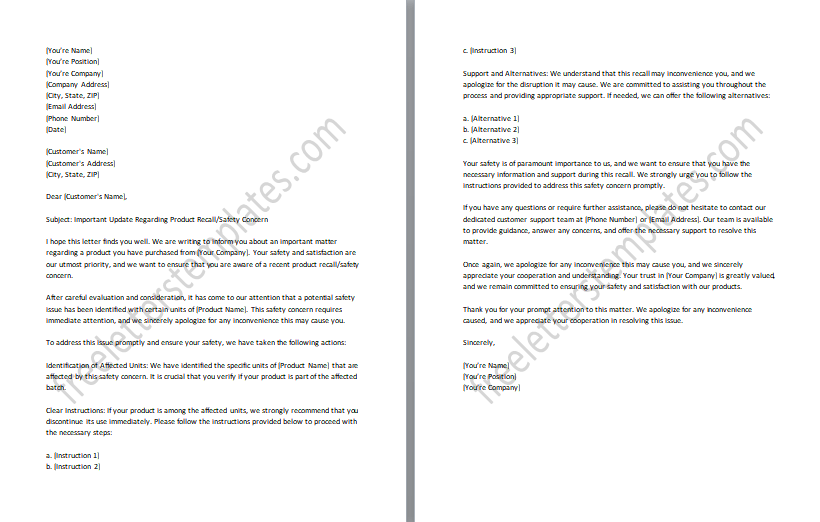
#11: Appreciation for a customer referral:
Expressing gratitude to the customer for referring others to your business, highlighting the value of their referral, and possibly offering a token of appreciation. The purpose of this letter is to express gratitude to the customer for their customer referral. The letter highlights the value of their referral and acknowledges its contribution to the growth of the business. It may also mention the possibility of offering a token of appreciation as a gesture of thanks. By reaching out, the letter aims to show appreciation for the customer’s trust and support, encouraging them to continue referring others to the business.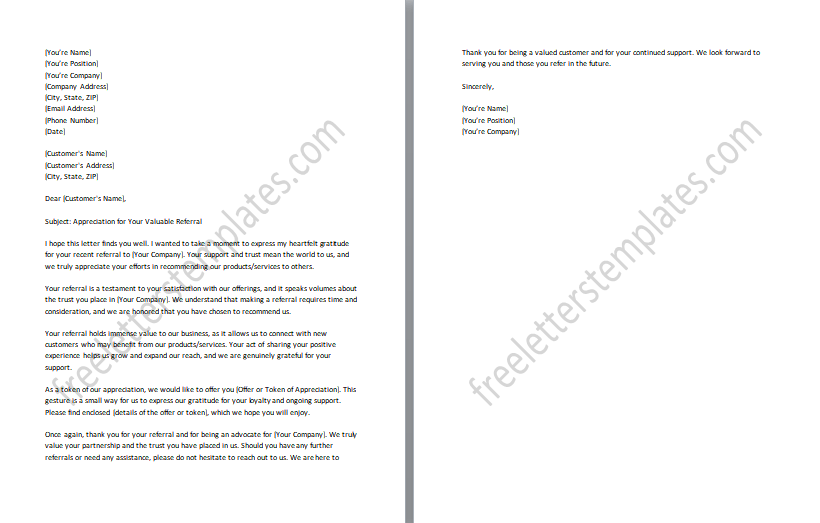
#12: Follow-up after a billing or payment issue:
Confirm the resolution of a billing or payment issue, reassuring the customer that the matter has been resolved, and offering assistance with any related concerns they may have. The purpose of this letter is to follow up with the customer after a billing or payment issue and confirm its resolution. The letter aims to reassure the customer that the matter has been successfully resolved, providing peace of mind. It also offers assistance with any related concerns they may have, ensuring their satisfaction and maintaining a positive customer experience. By reaching out, we demonstrate our commitment to resolving issues promptly and maintaining a strong customer relationship.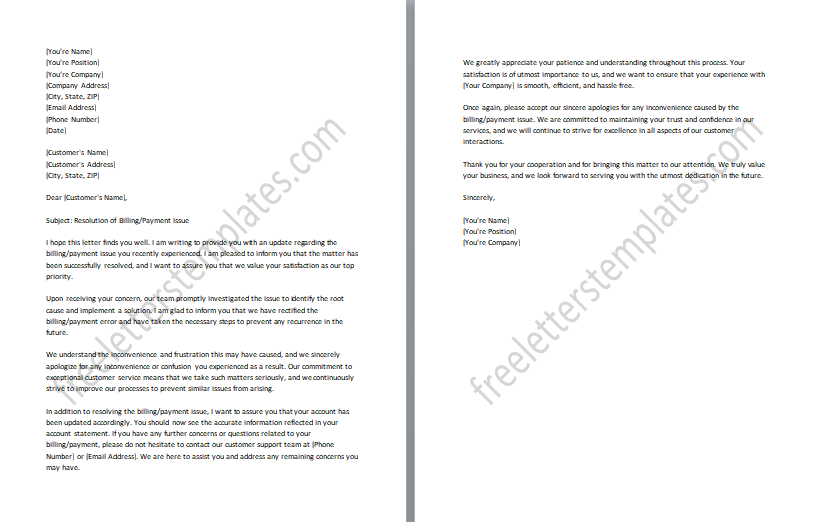
#13: Response to a customer’s request for assistance:
Providing a timely and helpful response to a customer’s request for assistance, addressing their concerns or questions, and offering guidance or solutions. The purpose of this letter is to respond to a customer’s request for assistance. The letter aims to provide a timely and helpful response, addressing the customer’s concerns or questions. It offers guidance or solutions to their specific situation, ensuring their satisfaction and resolving any issues they may be facing. By reaching out, we demonstrate our commitment to providing excellent customer support and assisting customers proactively and effectively.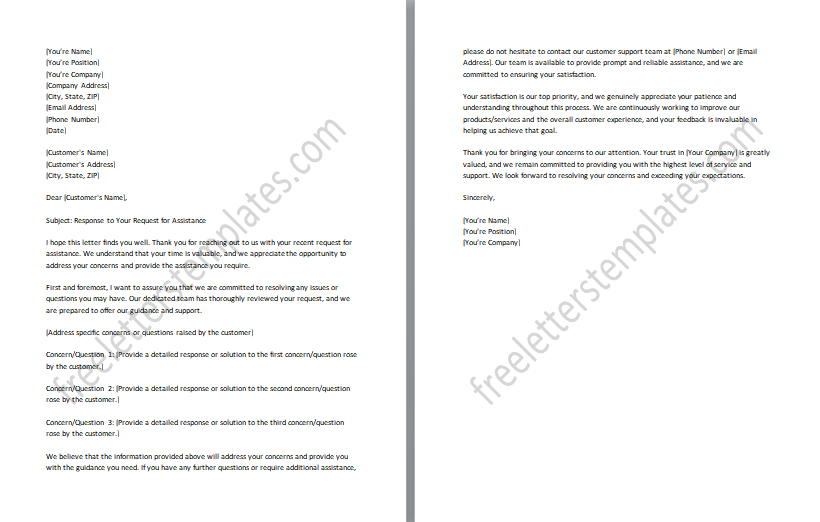
#14: Confirmation of a product warranty claim:
Confirming the acceptance and processing of a customer’s product warranty claim, informing them about the next steps, and providing any necessary instructions or documentation. The purpose of this letter is to confirm the acceptance and processing of a customer’s product warranty claim. The letter aims to inform the customer about the progress of their claim, outline the next steps in the process, and provide any necessary instructions or documentation. By reaching out, we strive to ensure transparency and keep the customer informed throughout the warranty claim process, providing them with the necessary support and assistance they need.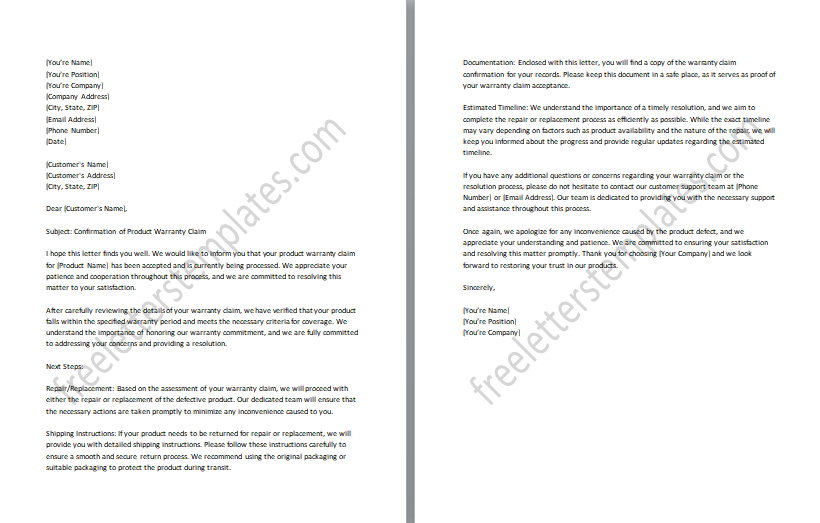
#15: Follow-up after a canceled or postponed event:
Informing customers about the cancellation or postponement of an event they were scheduled to attend, apologizing for any inconvenience caused, and offering alternative options or future event updates. The purpose of this letter is to inform customers about the cancellation or postponement of an event they were scheduled to attend. The letter expresses apologies for any inconvenience caused and offers alternative options or future event updates. By reaching out, the letter aims to ensure clear communication, address customer concerns, and provide solutions or updates to mitigate any disappointment caused by the event change.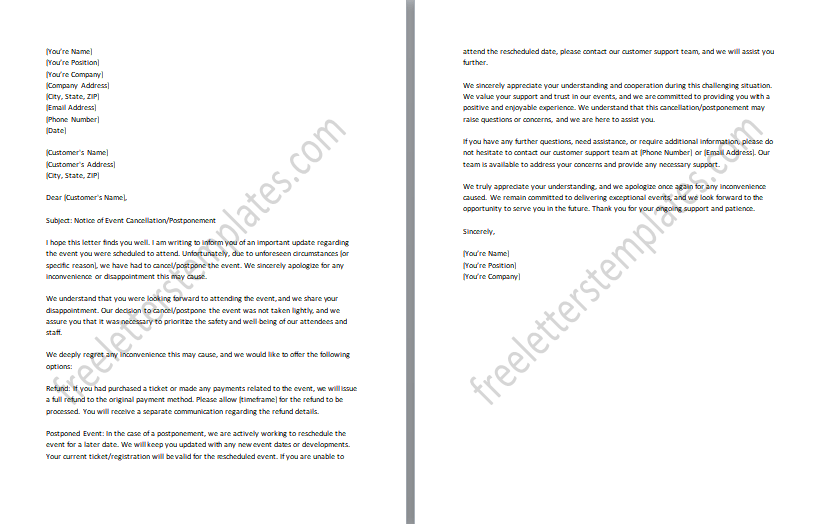
#16: Request for a customer testimonial or review:
Asking satisfied customers to share their positive experiences through a testimonial or review, explain the benefits of their feedback for your business, and provide instructions on how to submit their testimonial or review. The purpose of this letter is to request satisfied customers to share their positive experiences through a testimonial or review. The letter emphasizes the importance of their feedback for the business and highlights the benefits it brings. It also provides instructions on how to submit their testimonial or review, making the process convenient and straightforward. By reaching out, the letter aims to gather valuable customer feedback and testimonials to build trust, attract new customers, and enhance the reputation of the business.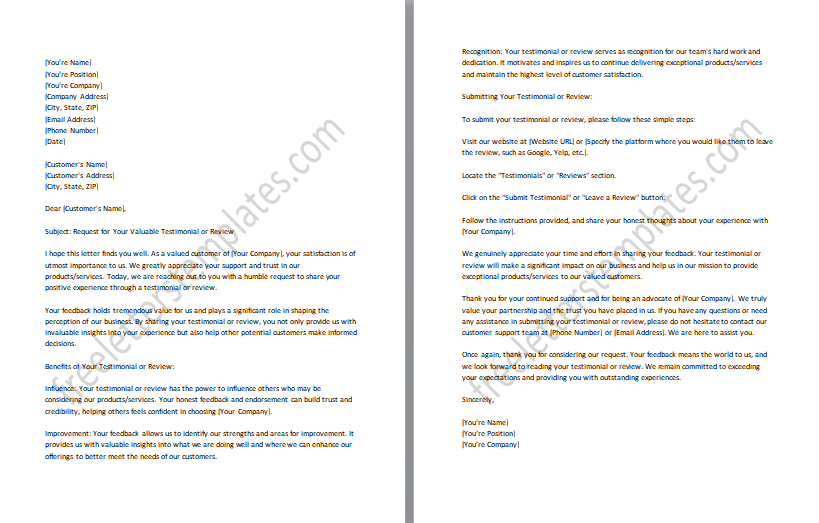
#17: Notification of a product upgrade or new release:
Informing customers about an upcoming product upgrade or new release, highlighting the features and benefits, and possibly offering exclusive discounts or early access. The purpose of this letter is to notify customers about an upcoming product upgrade or new release. The letter highlights the features and benefits of the new offering and may include the possibility of exclusive discounts or early access. By reaching out, the letter aims to keep customers informed about exciting updates, showcase the value of the new product or upgrade, and potentially incentivize them to explore and engage with the latest offerings from the business.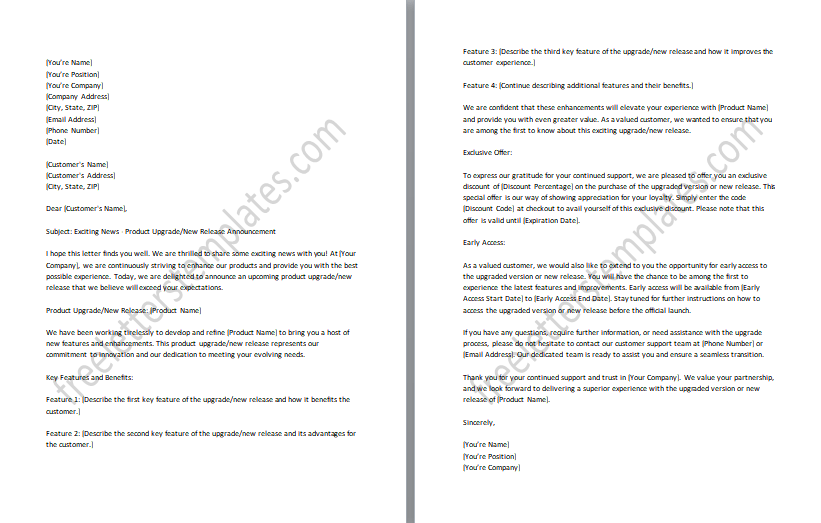
#18: Follow-up after a product trial period:
Follow up with customers who have recently completed a product trial period, inquiring about their experience, addressing any questions or concerns, and encouraging them to become paying customers. The purpose of this letter is to follow up with customers who have recently completed a product trial period. The letter aims to inquire about their experience, address any questions or concerns they may have, and encourage them to become paying customers. Its tone is friendly and supportive, emphasizing the importance of their feedback and offering assistance in making an informed decision. The letter expresses appreciation for their time and trust while expressing excitement to continue the journey together.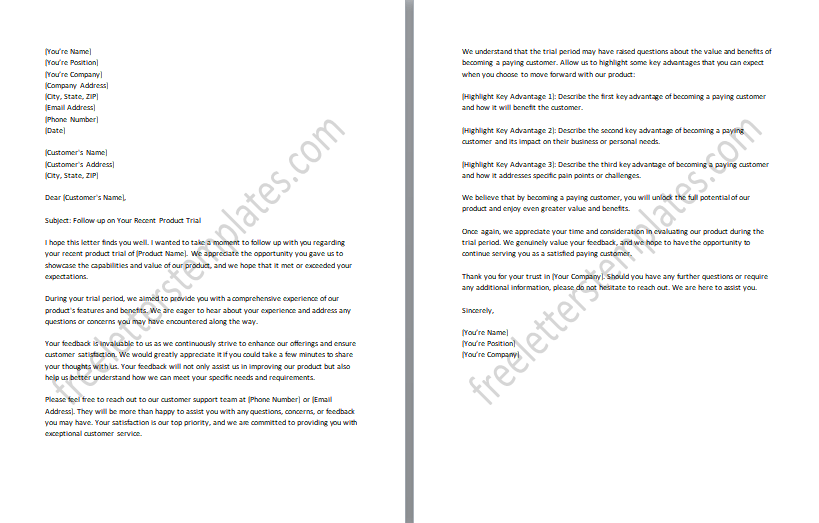
#19: The remainder of an upcoming subscription renewal:
Sending a friendly reminder to customers about their upcoming subscription renewal, providing renewal options, and highlighting the value they continue to receive from the subscription. The purpose of this letter is to remind customers about their upcoming subscription renewal in a friendly manner. The letter emphasizes the value they continue to receive from the subscription and provides renewal options. It aims to ensure customers have the necessary information to make an informed decision and to express gratitude for their continued support. The tone of the letter is customer-focused, highlighting the importance of their satisfaction and providing a seamless renewal process.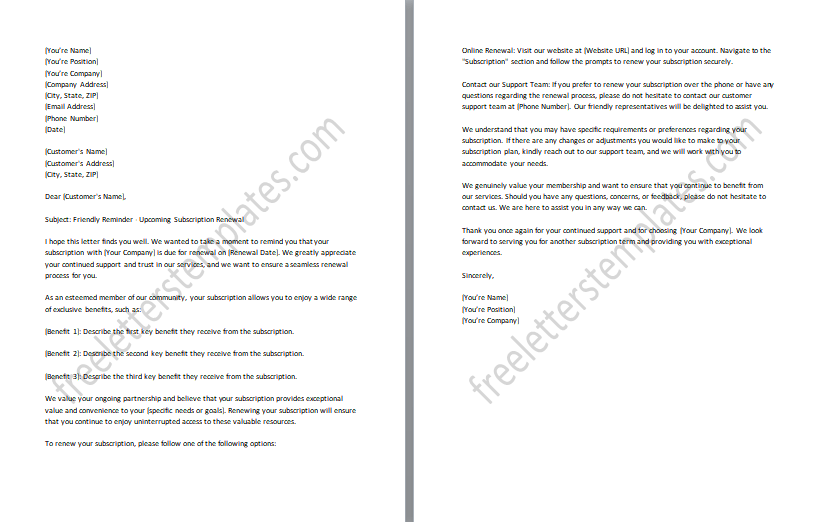
#20: Resolution of a customer’s technical support issue:
Informing the customer that their technical support issue has been successfully resolved, summarizing the steps taken, and offering any additional assistance or resources if needed. The purpose of this letter is to inform the customer that their technical support issue has been successfully resolved. The letter provides a summary of the steps taken to address the issue, ensuring the customer is aware of the actions taken to resolve their concern. It also offers additional assistance or resources if needed, demonstrating the company’s commitment to customer satisfaction. The tone of the letter is reassuring and helpful, aiming to provide a sense of relief and confidence in the resolution process.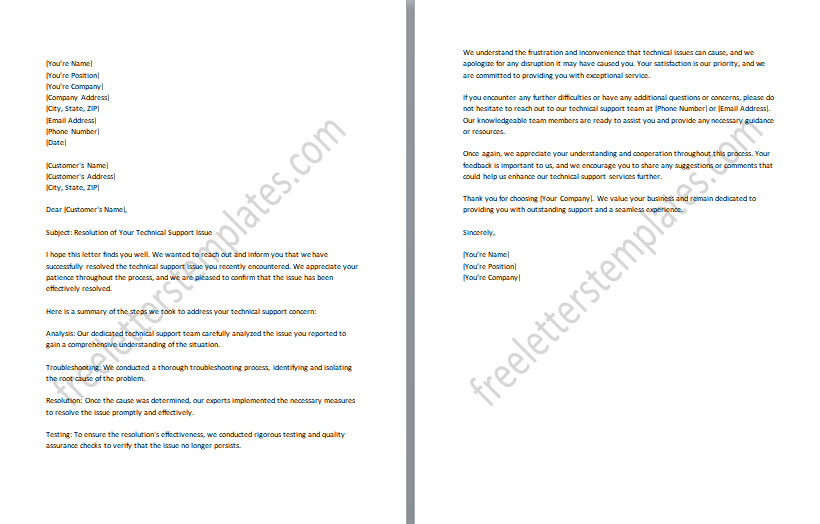
#21: Follow-up after a customer’s account suspension or cancellation:
Following up with a customer whose account has been suspended or canceled, addressing any concerns they may have had, and offering options for reactivation or alternative solutions. The purpose of this letter is to follow up with a customer whose account has been suspended or canceled. The letter addresses any concerns the customer may have had and acknowledges the impact of the account suspension or cancellation. It offers options for reactivation or alternative solutions, emphasizing the company’s willingness to work with the customer to find a suitable resolution. The tone of the letter is empathetic and solution-oriented, aiming to restore the customer’s trust and provide a positive path forward.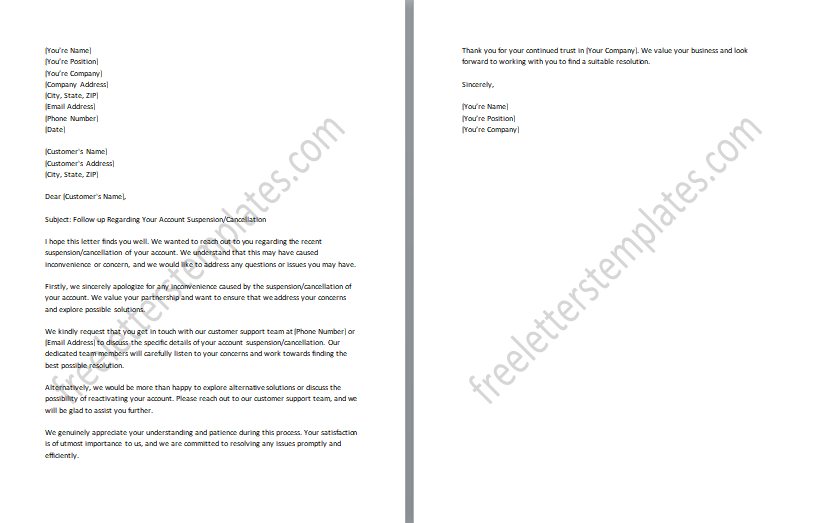
#22: Thank you for attending a company event or webinar:
Expressing gratitude to customers for attending a company event or webinar, summarizing key takeaways, and offering resources or follow-up materials related to the event. The purpose of this letter is to express gratitude to customers for attending a company event or webinar. The letter begins by acknowledging the customer’s presence and highlighting the value they added to the event. It then summarizes key takeaways from the event or webinar, providing a brief overview of the valuable information or insights shared. The tone of the letter is appreciative and informative, aiming to strengthen the customer’s connection with the company and provide continued value beyond the event or webinar.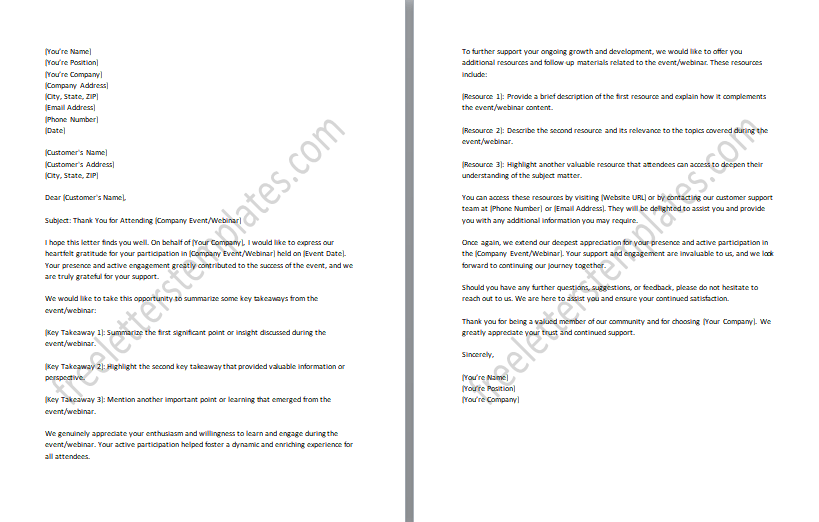
#23: Follow-up after a customer participates in a survey or feedback form:
Thanking customers for their participation in a survey or feedback form, summarizing the insights gathered, and highlighting any actions taken based on their feedback. The letter begins by thanking the customer for taking the time to provide their valuable insights and feedback. It then summarizes the key insights gathered from the survey or feedback form, highlighting the customer’s contribution to shaping the company’s understanding of their needs and preferences. Additionally, the letter emphasizes any actions taken based on the feedback received, demonstrating the company’s commitment to listening and making improvements.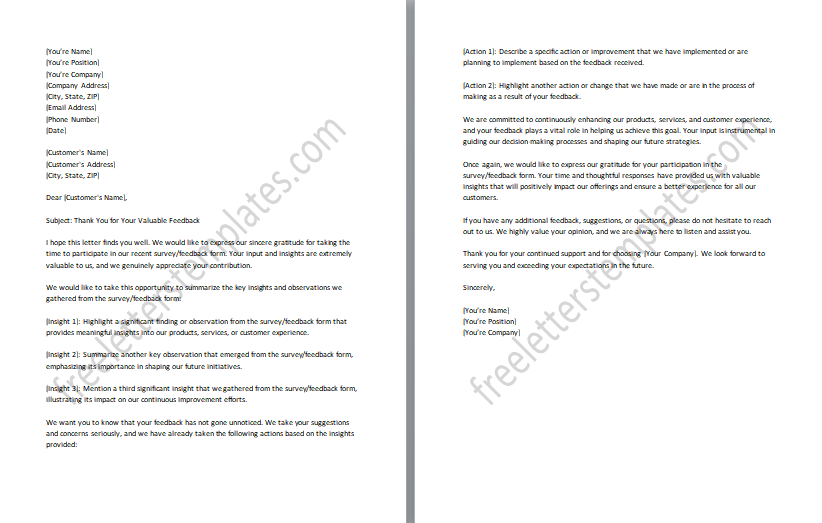
#24: Apology for a service outage or system error:
Apologize to customers for a service outage or system error that may have affected their experience, explain the issue, and assure them that steps are being taken to prevent future occurrences. The purpose of this letter is to apologize to customers for a service outage or system error that may have caused inconvenience or disruption to their experience. The letter begins by expressing sincere apologies for the inconvenience caused and acknowledges the impact it may have had on the customer’s satisfaction. It then provides a brief explanation of the issue, such as a service outage or system error, to offer transparency and understanding. The letter reassures customers that steps are being taken to prevent similar occurrences in the future, demonstrating the company’s commitment to improving its systems and services.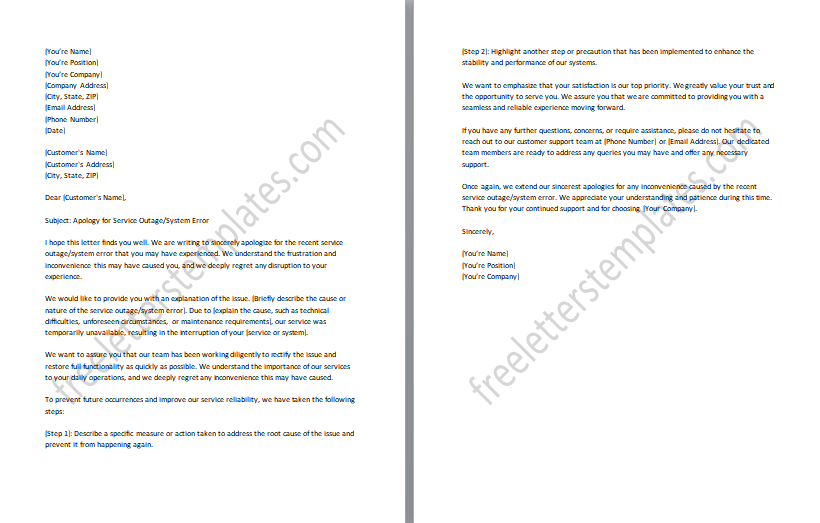
#25: Follow-up after a customer’s upgrade or cross-sell opportunity:
Follow up with a customer who has recently upgraded their product or made a cross-sell purchase, expressing appreciation for their continued support, and offering any necessary assistance or additional recommendations. The purpose of this follow-up letter is to express gratitude and appreciation to a customer who has recently upgraded their product or made a cross-sell purchase. The letter acknowledges the customer’s decision to invest in the company’s offerings and emphasizes the value of their continued support. It aims to strengthen the customer relationship by showing genuine appreciation for their loyalty. The letter also offers any necessary assistance or guidance to ensure the customer’s satisfaction with their upgraded product or cross-sell purchase.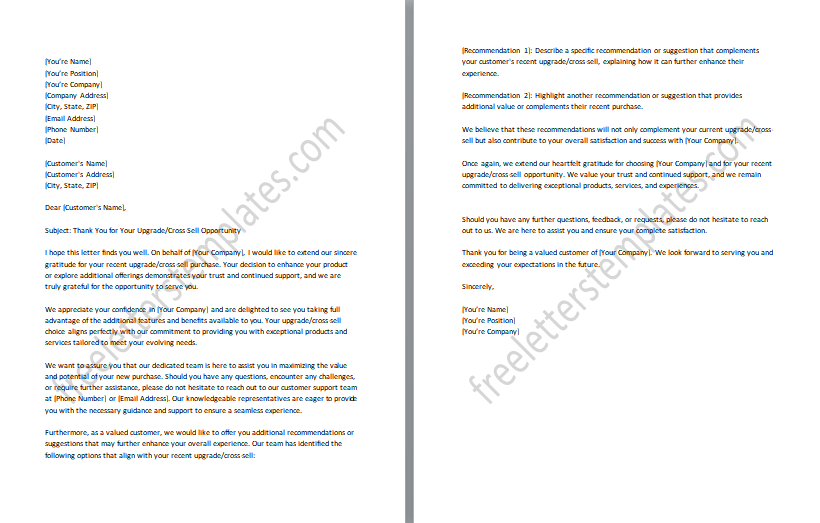
Follow-Up Timing
- Promptness: Aim to send the follow-up letter as soon as possible after the initial interaction or event. Sending it promptly shows your attentiveness and reflects your commitment to customer satisfaction.
- Balance: While promptness is important, avoid being too hasty. Give the customer enough time to process their experience or provide any necessary feedback before sending the follow-up letter.
- Event-Based Timing: For events or specific interactions, such as attending a webinar or receiving a service, send the follow-up letter within 24 to 48 hours. This timeframe ensures that the event is still fresh in the customer’s mind.
- Service Resolution: If the follow-up letter is related to resolving a customer’s issue or complaint, ensure that it is sent shortly after the resolution has been reached. This demonstrates your commitment to timely problem-solving.
- Survey or Feedback Forms: For follow-up letters related to customer surveys or feedback forms, send them within a reasonable timeframe after the submission. This allows you to acknowledge and respond to their feedback promptly.
- Personalized Timing: Consider the individual customer’s preferences and expectations. Some customers may appreciate the immediate follow-up, while others may prefer a slightly delayed approach. Tailor the timing based on their needs whenever possible.
Remember, the timely follow-up shows your dedication to excellent customer service and helps maintain a positive impression of your brand. Striking the right balance between promptness and giving the customer sufficient time ensures that your follow-up letter is well-timed and effective.
Customization Options
- Personalization: Encourage customers to personalize their follow-up letters by addressing the recipient by name and referencing specific details from previous interactions. This helps create a sense of individualized attention and shows that the letter is tailored to the recipient’s needs.
- The Tone of Voice: Highlight the significance of choosing an appropriate tone of voice for the follow-up letter. Customers can adapt the tone to match their brand’s personality and the nature of the customer relationship. For example, they can use a formal tone for professional interactions or a more casual and friendly tone for a more relaxed customer base.
- Content Customization: Advise customers to customize the content of the follow-up letter based on the specific purpose and desired outcome. They can highlight relevant information, address any concerns or feedback provided by the customer, and offer personalized recommendations or solutions.
- Brand Consistency: Encourage customers to align the style and language of their follow-up letters with their brand identity. This includes incorporating brand-specific elements such as logos, fonts, and colors. Consistency across all customer communications helps reinforce brand recognition and reinforces a sense of professionalism.
- Targeted Messaging: Emphasize the importance of crafting targeted messages in follow-up letters. Customers should consider the recipient’s specific needs, preferences, and past interactions to create a personalized and meaningful follow-up. This approach shows that the customer’s individual experience matters and builds a stronger connection.
Leaving a Lasting Impression through Follow-up Letters
In conclusion, customer service follow-up letters play a vital role in nurturing customer relationships, addressing concerns, and solidifying a positive brand image. These letters provide an opportunity to express gratitude, address any outstanding issues, and reinforce your commitment to exceptional customer service. By personalizing the content, offering helpful tips, and sending them promptly, you can create meaningful connections with your customers and leave a lasting impression. Harness the power of follow-up letters to showcase your dedication to customer satisfaction and build long-lasting relationships with your valued customers. Elevate your customer service experience with thoughtful and well-crafted follow-up letters that demonstrate your genuine care and commitment to their needs.